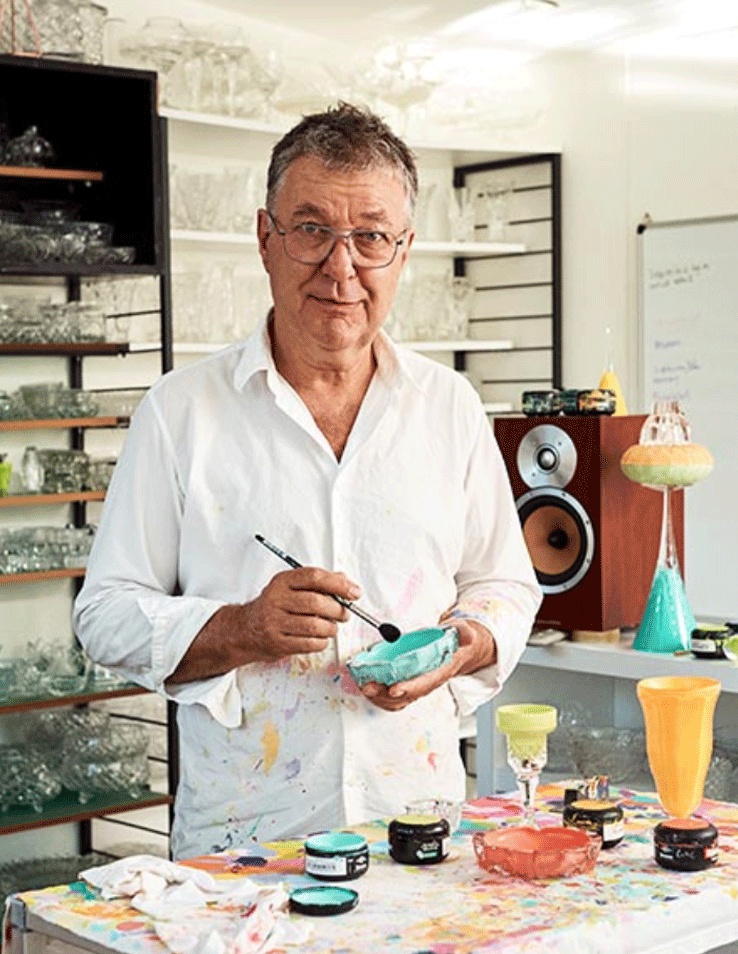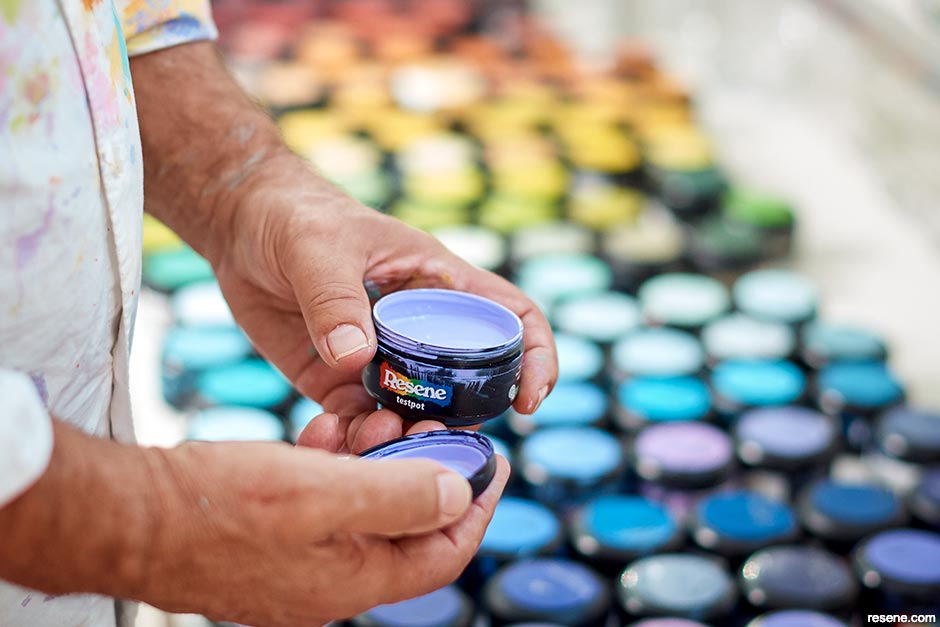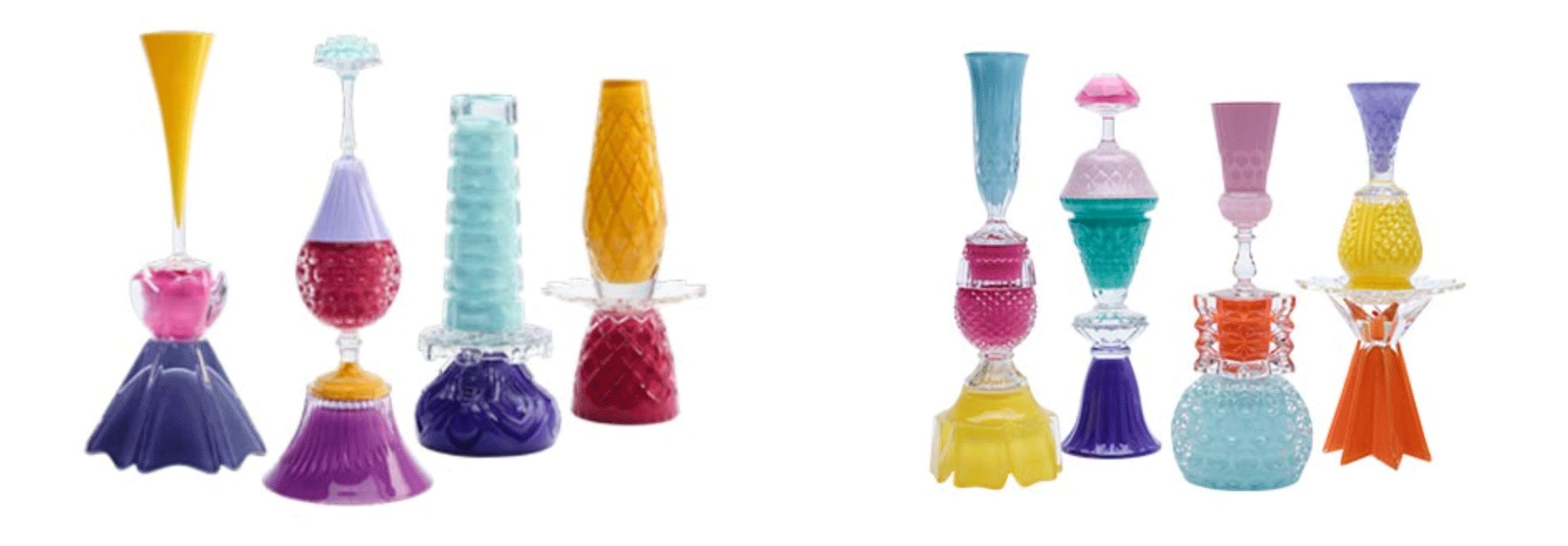
Artist Edward Waring’s studio brims with what were once precious objects that have since been discarded, which he repurposes into unique and colourful sculptures called ‘Memory Sticks’ using Resene paint. His extensive collection of Resene testpots spans the spectrum and is nearing 200 in number. Images by Toby Burrows.
In a time when so many of the ornaments that fill our spaces are disposable, there’s a lot to be said for objects that were made to last but no longer fit within our tastes and design preferences. It’s a thought that artist Edward Waring has become deeply connected with. His latest collection encourages us to seek out the hidden beauty and excitement in what we now consider the mundane or prosaic and challenges us to dig deeper into often overlooked histories.
Originally from Lyttelton, Edward first left home to pursue fashion design at Wellington Polytechnic in 1973. But after a year and a half of studying, he realised that it wasn’t really what he wanted to do. He left the programme for a job with the Royal New Zealand Ballet where he worked his way from stagehand to stage manager. In 1979, Edward relocated to Sydney and worked in film and television before launching a company which supplied locations for photography and commercials. Since selling that business a number of years ago, he has been a fulltime artist focused primarily on sculptural assemblages of materials that were once prized and have since fallen out of use, such as old glass, Meccano toys and children’s dolls.
Lately, Edward has been focused on vintage crystal, repurposing and altering once cherished tableware to create ‘Memory Sticks’ which require the audience to reexamine what could be considered old-fashioned or passé and make space for them in the modern world. His use of things once saved for only the most special occasions asks the viewer to reconsider their past and allow forgotten feelings to resurface.
The idea for the collection was spurred when Edward was using vintage crystal to make a series of side tables and centrepieces and a friend asked if he could make him a coloured piece. “I scoured op shops and auctions but found it very difficult to find good coloured glass,” he says. “Then, one afternoon, I was in an art supply shop and saw a small container of blue oil paint and tried that. It didn’t work, as the colour looked flat and drab. A few weeks later, I went to the Resene ColorShop in Artarmon and they had a table covered with discounted testpots, so I bought a few and tried them on the glass. I was so happy with the result, I went back and bought most of what was left. I have since added many more Resene testpots to my supply.”
For Edward, the crystal pieces evoke memories of the ones his mother and her friends owned when he was growing up, which were mostly kept tucked away and seldom, if ever, used. In a way, the tucking away of the tableware echoes these women’s own secret and fabulous histories which are rarely narrated or acknowledged. By unearthing these objects from the cupboards that have kept them hidden and treating them to a playful and dynamic reimagining, Edward says the artworks become a tribute to the strong women who raised his generation.
Artist Edward Waring’s studio brims with what were once precious objects that have since been discarded, which he repurposes into unique and colourful sculptures called ‘Memory Sticks’ using Resene paint. His extensive collection of Resene testpots spans the spectrum and is nearing 200 in number. Images by Toby Burrows.
“Memory is always present in my practice. I’m fascinated with the idea that something that was once loved is discarded as people grow or their tastes change, and I like to give these objects a contemporary spin to bring them back into people’s lives. I recently had a collector buy a group of four, and when he got them home, he was thrilled to find out that one of them was titled ‘Lorna’ – which was his mother’s name. He told me that whenever he looks at it, he thinks fondly of his mum – and that to me is mission accomplished.”
Edward acquires most of his materials by trawling op shops and auction houses. “I don’t tend to use online channels to find them as I really need to see the pieces in person to make sure they are not tarnished or chipped, and to see how they respond to light,” he says. “Then, I start assembling the individual pieces into a form I’m happy with – first, choosing a piece for the base, then experimenting with what works next. I pace my studio looking at the myriad of possibilities and keep swapping and stacking until I have a form I’m happy with. I then leave it for a few days to see if I think it’s fit to paint. Once I’m locked into the form, I hand-paint the interior of each piece – again, by picking a colour for the base object then experimenting with what goes next. I usually paint each piece a minimum of five or six coats and sometimes up to 10 or more depending on the colour and how it responds to the glass before permanently connecting the pieces together.”
Edward’s artworks are included in private collections both in Australia and abroad and in public collections such as The Powerhouse Museum and The Art Gallery of New South Wales. He has also been a finalist in prize exhibitions including the Reimagine Art Prize and Woollahra Small Sculpture Art Prize. His most recent collection, assemblages called ‘Memory Sticks’, are coloured with Resene testpots.
When asked about his favourite Resene colour, Edward said picking out just one is an impossible feat. “It’s like asking what my favourite record is. It depends on the day, my mood and the feeling I am attempting to evoke. Some days I’ll get fixated with greens and bounce off from there. Other days, it will be blues or oranges and reds. I tend to work quite instinctively; once I pick a colour for the base, I then try different combinations for the rest until I’m happy with the whole piece.”
To inspire ideas for his colour combinations, Edward often looks to comic books – another memory from his childhood. “My major influence is a French graphic novelist and illustrator called Jean Giraud, who used the pen name Moebius. His colour palette is extraordinary and inspirational. However, I’m always looking for different ideas. Sometimes I’ll see a beautiful bunch of flowers or a painting and will work those colours into my next piece.”
Edward says that while discovering Resene was “a very happy accident”, once he started using the paint, he became hooked. “I now use it exclusively. Obviously, I love the colours, but I also really like that I can buy 60 mL testpots so I have zero wastage – and the staff at the Resene ColorShops are super helpful.”
Of course, since both crystal and colour are greatly affected by light, Edward’s works are best experienced in person. Luckily, those who are eager to view them up close will have an opportunity in the coming months during his solo exhibition at Gallery Sally Dan-Cuthbert (20 McLachlan Avenue, Rushcutters Bay, NSW), which opens 13 July and runs until 13 August 2023.
› To see more of Edward’s sculptures, www.gallerysallydancuthbert.com.






